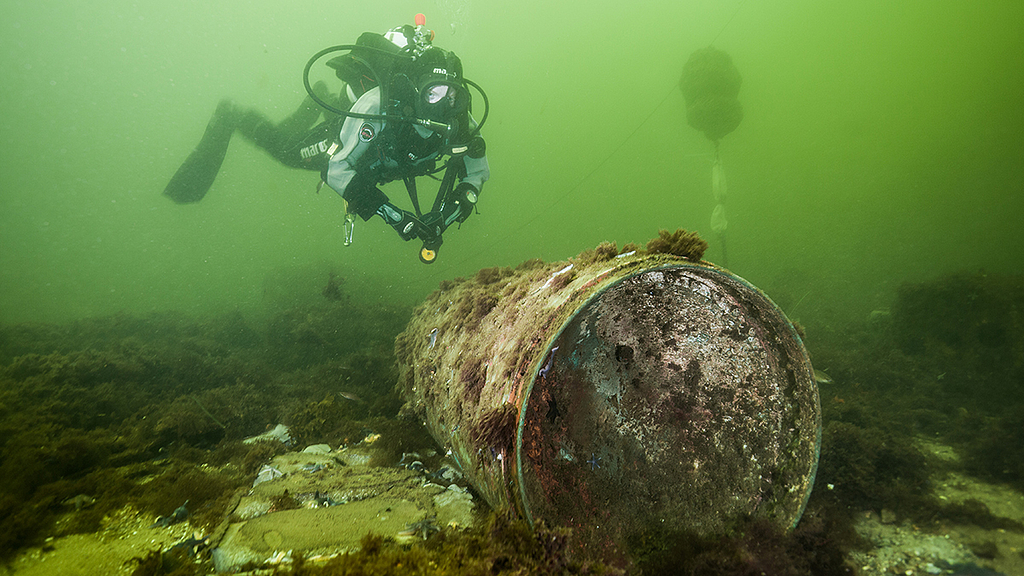Incidents involving wrecks and munitions in the German North Sea
Between 1945 and 2008, at least 115 people were killed by munitions sunk or dumped in the German North Sea alone. In addition to munitions left over from or dumped after the war, unexploded naval mines are a further source of danger.
The last case of a vessel being sunk by a mine in the North Sea occurred in 1960, when a cargo ship named the Marmara veered off course and triggered a bottommine. Decades on from the war, mines are still being found today, and these need to be either recovered or detonated.
The necessity of this is emphasised by the tragic case of three Dutch fishermen who died in 2005 after landing a World War Two bomb. Following this incident, mine-clearing operations were stepped up in the area.
On December 2020, the crew of the British fishing boat Galwad-Y-Mor had their own potentially fatal encounter with unexploded ordnance (UXO). In this case, the fishermen narrowly escaped with their lives, though some were seriously injured.
The recovery of munitions from the two world wars is a huge challenge, as illustrated by the case of the cargo ship SS Kielce, which, in 1946, sank 6.4 km off the coast of England along with its load of munitions. Its attempted salvage in 1967 resulted in an explosion equivalent to an earthquake measuring 4.5 on the Richter scale. The force of the blast was picked up by seismographs as far away as the USA.
Other similarly dangerous wrecks still remain in the North Sea: in 1944, the Liberty ship SS Richard Montgomery, for instance, ran agroundin the Thames estuary with 1,400 tonnes of munitions on board. At low tide, its masts can still be seen today.
Another concern is poison gas: off the Belgian coast near Knokke, for instance, leaks of mustard gas from munitions dumped after World War One have been detected in recent years.
The dangers of unexploded ordnance have to be balanced with the harms caused by its detonation. Such explosions create new environmental problems, killing sea creatures with their shockwaves, disorientating whales that then run aground, and dispersing fine TNT particles in the water.
On the other hand, if these underwater obstacles are not dealt with, they could also put at risk projects that have long-term environmental benefits, such as the construction of wind farms that generate clean energy.
Sources:
BBC, 23.12.2020: Fishing boat explosion: Seabed munitions may have caused blast off Norfolk, https://www.bbc.com/news/uk-england-norfolk-55422884
BBC, 28.10.2015: The bombs that lurk off the UK coast, www.bbc.com/future/article/20151027-the-ticking-time-bomb-of-the-thames
Government of the Netherlands, 24.08.2012: Navy disarms 1.000the explosive, https://www.government.nl/latest/news/2012/08/24/navy-disarms-1-000th-explosive
Nehring, Stefan. 2008. „Legende oder Wirklichkeit? Munitionsversenkungen durch die Bundesrepublik Deutschland“. In: Waterkant 23 (4): 9-15, http://www.stefannehring.de/downloads/190_Nehring-2008_Waterkant-4-08_munition-BRD-versenkungen.pdf.
The Guardian, 03.11.2020: Stop blowing up bombs on the sea floor, say whale campaigners, www.theguardian.com/environment/2020/nov/03/stop-blowing-up-bombs-on-sea-floor_say-whale-campaigner
Washington Post, 03.05.2019: Deadly gases may be starting to leak from Europe’s World War weapons cemeteries, www.washingtonpost.com/world/2019/05/03/deadly-gases-may-be_starting-leak-europes-world-war-weapons-cemeteries/
Partner
-


